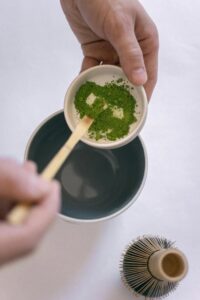Yesterday I posted a recipe for homemade wonton wrappers, the first step in making one of my favorite soups- wonton soup. Today I’ll be sharing part two of the recipe- the broth and the wonton fillings.
.JPG) |
| Finished wonton soup. Yum yum, delicious! |
Wonton Soup Recipe
Ingredients
Wonton Wrappers
Salt water for boiling or
Oil for deep frying
Broth Ingredients
Chicken parts (see below)
Water
1 inch fresh ginger, peeled and cut in slices (this can be adjusted to taste if you don’t like ginger as much)
4 scallions, chopped up
Salt- to taste
Soy sauce- to taste
Wonton Filling Ingredients
1/2 lb chopped or ground “meat” (see below)
3 scallions, chopped
1 tablespoon soy/tamari sauce
1 teaspoon honey or sugar
1 teaspoon black pepper (optional)
Broth Instructions
1. To make the broth, first boil chicken parts in unsalted water. You can use whatever chicken parts you want, from chicken bones to chicken fat and scraps to regular chicken pieces. I’ve also used chicken gizzards for the wonton filling and used the water in which I cooked the gizzards for the soup.
2. Once the chicken broth is all cooked, add the ginger and scallions and simmer for 15 minutes.
3. Add salt and soy sauce to taste.
.JPG) |
| The makings of wonton soup broth- water from cooking chicken gizzards, scallions, ginger. All that’s missing is the soy sauce. |
Wonton Recipe
1. Decide what “meat” you will be using for your filling. Standard wonton filling is made with ground pork, but I’ve successfully made the filling with ground chicken, ground beef, ground turkey, a mix of ground beef and TVP, ground chicken hearts, and ground chicken gizzards. I reckon it can also be made with ground seitan, but I haven’t tried it yet. The choice of meat for fillings is limitless- I just use whatever I have around the house that I can get for cheapest. Organ meats are pretty cheap around here, so I just cooked the organ meat first (because it is too tough for me to grind up raw), zipped it in my food processor attachment for my blender stick, and used that in place of the other raw meats. You want the meat to be sticky and able to stay together, so if you see the meat is too dry or crumbly (as happened when I used the gizzards, and would probably happen with ground seitan), you can also add an egg to the mixture.
2. Mix your meat with 1 tablespoon soy sauce, 1 teaspoon sugar, 3 chopped scallions and 1 teaspoon of black pepper.
.JPG) |
| Filling, unmixed. |
.JPG) |
| Filling, all combined. |
3. Bring a large pot of salted water to a boil, as if you were cooking noodles (which, in essence, you are).
4. Take homemade wonton wrappers (or in a pinch, store bought wonton wrappers) and put them on a flat surface.
5. Take a cup of water and keep it near your wonton wrappers.
Using a spoon, scoop a small amount of wonton filling into the center of the wrapper. You don’t want to use too much, because you need to be able to close the wrapper without the filling leaking out the side. If filling goes onto the side, the wonton will not seal properly.
.JPG) |
| Filling placed on the wrapper |
6. Dip your finger in the water, and along 2 adjacent sides of the wonton, paint a very light bit of water. Too much water and it will become a sticky mess and hard to work with, too little water and it will not stick together. This water, combined with the starch already on the wrapper, works as a glue to hold your wontons together.
.JPG) |
| Water spread on the bottom edge. |
7. The two moistened sides touch each other at a corner. Take the corner diagonally across from that corner, pull it over the filling, and press it down on the first corner.
.JPG) |
| The dry corner pulled over to meet the wet corner. |
You want to make sure not to push out the filling- instead of just picking up the corner and putting it down, stretch it so you don’t move the filling but are able to put the two corners together.
Press down the corner, and then work your way outward from the right angle corner to the 45 degree angle corner next to it, pressing it down bit by bit, making sure the two pieces of dough are touching, with no filling getting caught in between. Then making sure that there is no air trapped next to the filling, seal the other edge. (If there is air caught, there will be an air bubble which will likely pop and cause the filling to leak out of the wonton.)
.JPG) |
| Sealing the first edge |
.JPG) |
| Sealing the second edge. |
I, then, like to gather the two acute angles of the wonton and fold them over to meet in the middle so they make a sort of pentagon, if the wontons will be boiled, but if I will be frying them, I just leave them as a triangle.
.JPG) |
| Pinching the two sides together. |
.JPG) |
| One wonton, ready to be cooked. |
.JPG) |
| A whole bunch of wontons, ready for cooking. |
9. If boiling, put the first batch of wontons in the boiling salted water, and cook until aldente. If you cook until they are soft, they will fall apart.
10. With a slotted spoon, take out the wontons from the salted water and put in a clean container.
11. If frying, put a healthier oil in a frying pan, heat until sizzling, then fry the wontons until golden, flipping once in the middle so both sides get fully cooked.
12. Cook the rest of the wontons in batches, then put in the broth immediately before serving.
.JPG) |
| The finished wonton soup. |
13. Garnish the soup with more scallions immediately before serving, and add a dash of soy sauce and or sesame oil if you desire.
14. Enjoy!
Note: The wontons should be made as close as possible to being served for best results.
Fried wontons also taste good in dipping sauce like duck sauce or chinese plum sauce.
Oh, and in case you were confused as to how the counters and filling and pots looked different from picture to picture, I didn’t take all the pictures the same time- they’re from different batches. One of them was made at my sister’s home with a beef and TVP filling, one was made at my home with a chicken gizzard filling. Just to eliminate confusion.
According to all reviews, this soup tastes much better than restaurant wonton soup. And, according to my sister, from whom I just made this soup at a family get together, this soup even tastes delicious cold, but you’ll have to take her word for that. (She insisted I include that in this post.)
Do you like wonton soup? Do you usually get it in restaurants or make it from scratch? How do you prefer fried or boiled wontons?
Linking up to Frugal Friday, Friday Food, Food on Friday and Whole Foods for the Holidays.

.JPG)



